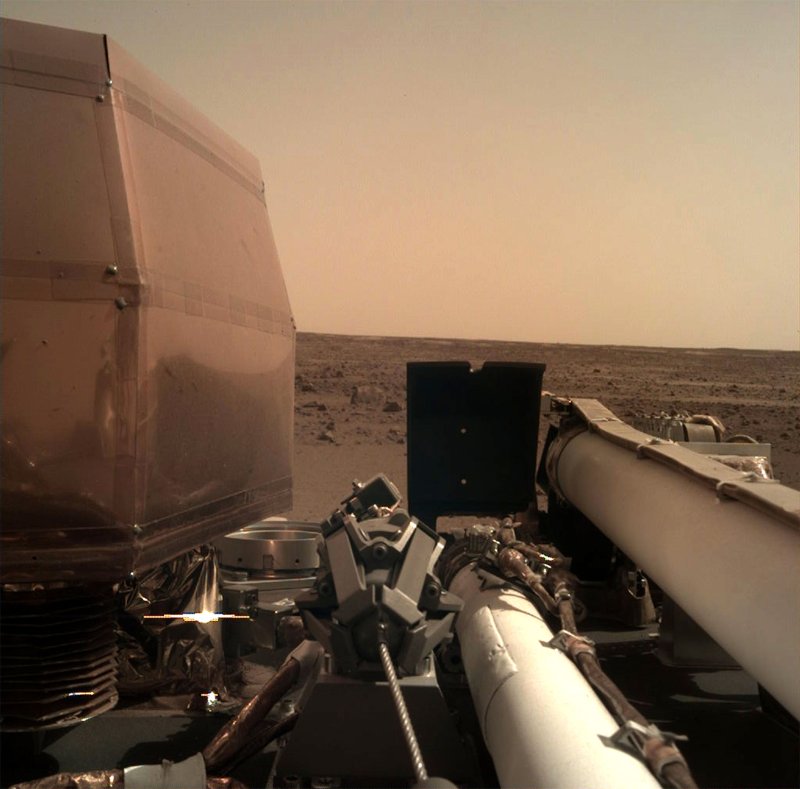InSight lander detects Marsquake for the first time
By Brooks Hays
APRIL 23, 2019

NASA's InSight Mars Lander has detected a seismic signal on the red planet for the first time, NASA and CNES announced. Pictured, a selfie of the lander taken with its robotic arm-mounted Instrument Deployment Camera on November 26, 2018, Sol 0. File Photo by NASA/UPI | License Photo
April 23 (UPI) -- For the first time, a tremor has been detected on the surface of Mars. The so-called marsquake was detected by the InSight lander's SEIS seismometer.
The seismic quake was so small it wouldn't have registered on Earth's surface, but because the Martian surface is so still, the instrument's sensor was able to detect the slight tremor. Unfortunately, the tremor was so small that it's signature failed to offer any insights into Mars' interior.
Scientists aren't sure what caused the miniature quake, but they're fairly certain it originated from inside Mars and wasn't caused by wind. Researchers are working to confirm what exactly triggered the vibrations.
Studying the structural makeup of the Red Planet's interior is the main scientific mission of NASA's Insight lander. While the first marsquake detected by SEIS won't aid the mission's cause, it is welcome evidence that the instrument is working.
RELATED Curiosity rover confirms source of seasonal methane spikes on Mars
"InSight's first readings carry on the science that began with the Apollo missions," Bruce Banerdt, principal investigator on the Insight mission and a researcher at NASA's Jet Propulsion Laboratory, said in a news release. "We've been collecting background noise up until now, but this first event officially kicks off a new field: Martian seismology."
Mars no longer hosts tectonic or volcanic activity, but it is still cooling and shrinking, causing layers of crust to warp and crack. Scientists think these internal processes generate tremors.
"We've been waiting months for our first marsquake," said Philippe Lognonné, principal investigator for SEIS instrument and a researcher with the French National Scientific Research Center, CNES. "It's so exciting to finally have proof that Mars is still seismically active. We're looking forward to sharing detailed results once we've studied it more and modeled our data."
RELATED Video: NASA tests helicopter for use on Mars
The instrument that detected the first marsquake was designed by a team of French engineers. It is extremely sensitive, and it is protected from the Red Planet's wind and extreme temperature swings by the Wind and Thermal Shield.
"The French SEIS seismometer is the cornerstone of space cooperation between France and the United States," said Jean-Yves Le Gall, president of CNES. "The instrument has barely begun its mission and it has already hit pay dirt with this world first revealing new insights into Mars, a planet that was habitable in its ancient past."
InSight lander detects Marsquake for the first time
By Brooks Hays
APRIL 23, 2019

NASA's InSight Mars Lander has detected a seismic signal on the red planet for the first time, NASA and CNES announced. Pictured, a selfie of the lander taken with its robotic arm-mounted Instrument Deployment Camera on November 26, 2018, Sol 0. File Photo by NASA/UPI | License Photo
April 23 (UPI) -- For the first time, a tremor has been detected on the surface of Mars. The so-called marsquake was detected by the InSight lander's SEIS seismometer.
The seismic quake was so small it wouldn't have registered on Earth's surface, but because the Martian surface is so still, the instrument's sensor was able to detect the slight tremor. Unfortunately, the tremor was so small that it's signature failed to offer any insights into Mars' interior.
Scientists aren't sure what caused the miniature quake, but they're fairly certain it originated from inside Mars and wasn't caused by wind. Researchers are working to confirm what exactly triggered the vibrations.
Studying the structural makeup of the Red Planet's interior is the main scientific mission of NASA's Insight lander. While the first marsquake detected by SEIS won't aid the mission's cause, it is welcome evidence that the instrument is working.
RELATED Curiosity rover confirms source of seasonal methane spikes on Mars
"InSight's first readings carry on the science that began with the Apollo missions," Bruce Banerdt, principal investigator on the Insight mission and a researcher at NASA's Jet Propulsion Laboratory, said in a news release. "We've been collecting background noise up until now, but this first event officially kicks off a new field: Martian seismology."
Mars no longer hosts tectonic or volcanic activity, but it is still cooling and shrinking, causing layers of crust to warp and crack. Scientists think these internal processes generate tremors.
"We've been waiting months for our first marsquake," said Philippe Lognonné, principal investigator for SEIS instrument and a researcher with the French National Scientific Research Center, CNES. "It's so exciting to finally have proof that Mars is still seismically active. We're looking forward to sharing detailed results once we've studied it more and modeled our data."
RELATED Video: NASA tests helicopter for use on Mars
The instrument that detected the first marsquake was designed by a team of French engineers. It is extremely sensitive, and it is protected from the Red Planet's wind and extreme temperature swings by the Wind and Thermal Shield.
"The French SEIS seismometer is the cornerstone of space cooperation between France and the United States," said Jean-Yves Le Gall, president of CNES. "The instrument has barely begun its mission and it has already hit pay dirt with this world first revealing new insights into Mars, a planet that was habitable in its ancient past."
InSight lander detects Marsquake for the first time
